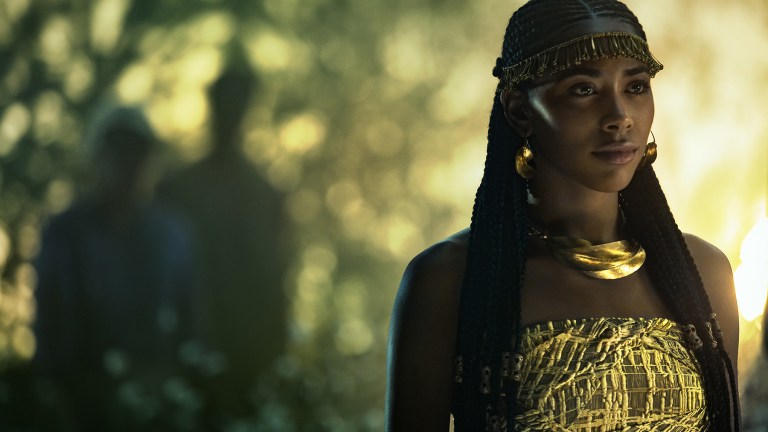American Gods Season 3: Who Are The Orisha?
A new entry into the pantheon of American Gods, Orisha may not be as familiar to the audience as the European pantheon, but their roots run deep in Africa’s most populous country and beyond.

This article contains spoilers for American Gods season 3 episode 4.
American Gods star Yetide Badaki, known to fans of the show as love goddess Bilquis, has an upbringing as unique as any fictional character from Neil Gaiman’s fantasy novel.
She lived in England for three years, has lived in American since age 12, and went to college in Canada, but Badaki’s roots are planted in the soil of the country of her birth, Nigeria. Nigeria, Africa’s largest country, serves as the centerpiece of the larger tribal community known as Yorubaland along with Benin, Ghana, and Togo. Yorubaland is home to 55 million people and was one of the largest sources of the enslaved people to the United States of America. It’s also home to spirit world entities which are now about to enter into the American Gods’ canon: The Orisha.
Far from being a relic of the past, the Orisha still play an active part in African religion to this day, and it was something that Badaki was keen to see brought to the screen.
“There are quite a few fascinating gods and goddesses that I’d like to see, but my answer would be the Orisha,” Badaki said when asked about possible additions to the American Gods pantheon. “I can’t wait for everybody to meet all of them.”
The Orisha are hinted at in episode 2, when a young Shadow Moon stares at a cover of a magazine touting the beauty of Nigeria, with the face on the cover of the magazine speaking to him. Their proper introduction comes at the beginning of episode 4 “The Unseen,” where slaves break their shackles with the help of the Gods of their old world, with the Orisha promising, among other things, freedom and their strong blessing. Four new members of the pantheon of American Gods are pictured: Chango, Oshun, Yemoja, and Aye.
In the original Yoruban tales, the Orisha are spirits sent by Olodumare (the source of creation) to guide all creation, with particular emphasis on the guidance of humanity as seen in the cold opening of “The Unseen.” The number of Orisha varies depending on the telling, with the group being either 400, 700, 1440, or more than anyone can think of, plus one more. That extra plus one, always handy on a guest list, ties the number of Orisha to a sacred number in traditional beliefs.
Orisha straddle the world between the realm of spirits and men, with Orisha being either spirits born into the bodies of humans, or humans who have done such great deeds in life that they become Orisha through the power of their actions. They also serve as intercessors with Oludumare, speaking on behalf of their followers according to their areas of experience.
So just who are these Orisha and what are their particular interests?
The most noteworthy initial appearance is that of Chango, who breaks the chains to free the captive in the fields. Chango, played by Nigerian-American rapper and actor Wale, is the most fearsome and dangerous of the Orisha. An early leader of the Oyo Empire, Chango was a vengeful conqueror whose seven years at the head of the kingdom marked by constant warfare and conquest until his palace was struck by lightning and killed.
Chango is known as the God of Iron who casts down thunderstones to smite those that displease him with lightning, and stones formed by lightning strikes are sacred to his followers, who span across the African diaspora from traditional Yoruba worship to Santeria and both Haitian and Louisiana variants of voudou/voodoo. Chango, as befitting a warrior, is represented by his two axes, the thunder of both sky and drum, and the color red. He is a renowned ladies’ man (he has three wives, after all) and the Orisha known for his ability to dance and love of a good party. Fittingly, his consecrated worship day is Wednesday, a fact that I am certain will be important later.
Alongside Chango is his queen and wife, Oshun, as played by American singer and actor Herizen F. Guardiola. Alongside Chango, Oshun has been widely adopted across a variety of religions, with an especially strong presence in the Afro-Brazilian religion Candombele, where she is revered as the Lady of Gold and is a patron of wealth and prosperity, with the bright yellow of flowers and the ritual fan called the Abebe being associated with her worship. As queen and wife, she is also known as the protector of pregnant women and children, and a powerful goddess of love.
Her name is linked to Nigeria’s Osun river, and in traditional Yoruba beliefs, she is the goddess of fresh water and waterfalls, with her worshippers paying tribute to her at lakes, streams, and canals; as the messenger of the Orisha, she is commonly associated with peacock feathers, having transformed herself to get a message to Oludumare during a great drought. In Cuba, she is celebrated with a type of violin performance known as Violin for Osun, a blend of Western classical music and Cuban popular music; Guardiola’s father is a Cuban reggae musician, making this a fitting pairing.
Yemoja, played by Bridget Ogundipe, is another powerful spirit tied to water and birth, as she is the mother of humanity. When her water broke at the birth of the human race, it created the very waters of the rivers and seas that sustain us. As such, she has a powerful tie to motherhood and is a goddess pertaining to everything related to women, from conception and parenting to love and the “feminine mysteries”. As befitting a good mother, she is very slow to anger, but capable of great destruction as anyone who lives on a flood plane could attest.
As someone tied to both womanhood and the water (rivers in Yorubaland, the ocean and seas throughout the Caribbean diaspora), she is often depicted as a mermaid, or as a nursing mother. (Her name is a contraction for the Yoruban words that translate ‘mother of fish children’.) Her colors are the colors of clean water, blue and crystal, and her symbols are anything related to the ocean, from shells and fish to anchors. Festivals are held for Yemoja throughout the world, particularly in Cuba, Brazil, and Uruguay, with worshippers traveling for miles to congregate at beaches and shrines and send offerings out to sea for Yemoja in small boats.
Last, but certainly not least, is Aye, played by Karen Glave. Of all of the Orisha, who all go by a variety of names depending on what religious tradition they are a part of; she is the one that is most difficult to track down. Yet, of all the Orisha, perhaps she is the most powerful. Aye is the Yoruban version of Mother Earth. More than simply being the planet on which we all tread, Aye is the force of creation given life. More than just a mother figure, she is a creator figure; a Yoruba saying goes “You have Aye; I have Aye; we all have Aye in our pockets.”
To attempt to sum up Aye in a single phrase? She is power. Specifically, the power of Black women. Gestating life, creating a work of art, building a town, organizing a revolution? All of these things fall under the purview of Aye, because she is the great creative force without whom the Earth would have never existed; the male Orisha attempted to leave women out of the creation process and failed miserably until Oshun agreed to participate and Aye was born. As such, it is the labor of many working together who tap into Aye’s great power, a collective greater good in which displays of wealth are forbidden and sharing is not encouraged, but required. If you have ever known a kindly older woman who could cure a cold by administering a hot drink and applying salve, you have known one of Aye’s iyalawo (mothers of mysteries).
When your spirits cross oceans and spread out across thousands of years, dozens of countries, multiple languages, and four continents, having accurate information can be an issue. The information presented above is by no means exhaustive, as the Orisha themselves cover many skills and cross many boundaries depending on the belief system examined. As the Gods changed in their time in America, the Orisha have changed throughout history thanks to the power of syncretism with Roman Catholic saints, Islam, Pentecostalism, Chrislam, and many, many other beliefs.
While I have done my best to explain the powers of the Orisha, no mere mortal would ever be able to limit the power of an Orisha to text on a page.


